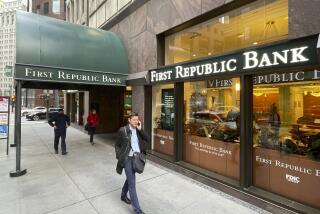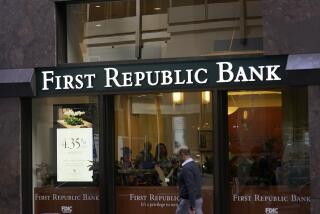‘Great Deal of Interest’ in Flagship Federal : Ailing S&L; Is Nearly Ready for Sale
- Share via
SAN DIEGO — Flagship Federal Savings, the federally chartered thrift that opened after Sun Savings & Loan’s failure of July, 1986, will be ready for sale by year’s end, according to the Great Western management team that is operating the thrift for federal regulators.
“There is a great deal of interest in buying Flagship,” according to Ralph C. McNitt, a Great Western executive vice president who is also Flagship’s chief operating officer. Great Western manages Flagship through the Federal Savings & Loan Insurance Corp.’s management consignment program.
Both “individuals and institutions” have expressed interest in acquiring the S&L; that had $154 million in assets, $85 million in total loans and a $5-million negative net worth on June 30, McNitt said. Much of that interest comes from out-of-state buyers who see Flagship as a potentially attractive way to enter the booming Southern California market.
Those inquiries continue despite a $5-million operating loss that Flagship has generated since opening.
During a Tuesday lunch with reporters, McNitt played down the importance of the losses, stating that the S&L; “was programmed to lose money” during its first few months.
The losses were expected, according to McNitt, because Flagship is burdened with a “negative spread,” meaning that the S&L;’s interest payments to depositors are higher than interest it collects on performing loans.
To that end, a three-man Great Western management team has concentrated on shrinking Flagship’s dependence on large, out-of-state deposits that demand heavy interest payments. Flagship is “building a local retail account base” with accounts of $100,000 and less, McNitt said.
Out-of-state deposits account for half of Flagship’s total deposits, down from 75% during Sun’s final days
The losses will continue, however, because Flagship has not yet started to make new real estate loans, McNitt acknowledged.
Additionally, Flagship’s loan portfolio is “not large enough to generate a sufficiently high level of income” because the FSLIC has been slowly transferring performing loans to the thrift, McNitt said.
In addition to performing loans, Flagship’s only other existing major earning asset has been a $300,000 note from the FSLIC that has “yielded considerably below the average cost of (Flagship’s) liabilities,” McNitt said.
The agency, however, has absorbed the losses because once the S&L; is healthy, Flagship and its five branches could draw a “premium” price.
McNitt on Tuesday praised the “innovative” method that the FSLIC is using to build Flagship’s loan portfolio.
Flagship’s $85-million loan portfolio includes performing loans that were originated by Sun Savings. The FSLIC also agreed to turn over $55 million of Sun’s non-performing loans to the Federal Asset Disposition Assn., which manages and markets non-performing assets for the agency.
However, “a significant number” of Flagships’ performing loans were transferred from other S&Ls; that have been declared insolvent.
The fairly unusual transfer mechanism, which steered loans to Flagship from three insolvent thrifts in California and Utah, has been used just 10 times since it was created in 1985, according to a FSLIC spokeswoman.
Typically, the FSLIC sells a failed institution’s assets to another institution or dips into its already-stretched insurance fund to pay off insured depositors.
Sun Savings, which was buffeted by red ink and a bitter board squabble during its last two years of existence, absorbed more than $17 million in losses during its last six quarters alone.
The troubled thrift reported a $2.4-million negative net worth on March 31, 1986.
More to Read
Inside the business of entertainment
The Wide Shot brings you news, analysis and insights on everything from streaming wars to production — and what it all means for the future.
You may occasionally receive promotional content from the Los Angeles Times.









